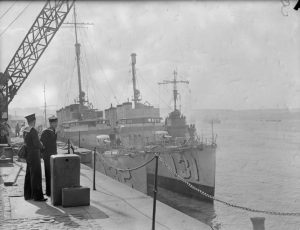Civil War Echoes: The Greatest Raid of All
One hundred years ago today, construction began on USS Buchanan (DD-131), a destroyer named for Franklin Buchanan, the first superintendent of the U.S. Naval Academy and later first admiral in the Confederate States Navy. She later played a role in one of the most famous raids of World War II.
Buchanan served a routine career in the U.S. Navy from her commissioning in 1919 until World War II’s outbreak in 1939. After a period on the Neutrality Patrol, on 9 September 1940 she was part of the 50 destroyers given to Britain in exchange for basing rights in the Western Hemisphere (also known as the Destroyers for Bases Agreement). The British renamed all 50 ships for towns both in the United Kingdom and the United States. Buchanan thus became HMS Campbeltown. In her new guise, and with British and Dutch crews, she fought German submarines in the Battle of the Atlantic until early 1942.
Meanwhile in London, British authorities were concerned about the threat of German surface ships operating in the Atlantic. Chief among these was the battleship Tirpitz, sister ship to the famous Bismarck sunk in 1941. Only one drydock in France could service her: the Normandie Dock at St. Nazaire. The British decided to destroy the drydock and thereby restrict Tirpitz to Norway. While a commando force went ashore to destroy machinery, an expendable destroyer would ram the dock gate. Explosives in her bow with a time fuse would then explode after the raid. The destroyer chosen for this mission was Campbeltown.
On the night of 27 March 1942, Campbeltown led 16 gunboats into the mouth of the Loire River. Aboard the group were 611 Royal Navy sailors and British Army Commandos. Campbeltown had been modified to resemble a German destroyer, and flew the German naval ensign. At 0122 on the 28th German shore batteries challenged her, and for six crucial minutes Campbeltown bluffed them into holding and ceasing fire. The Germans finally opened up, and Campbeltown’s commander, Lieutenant Commander Stephen Beattie, ordered the British ensign raised and increased her speed to maximum.
German fire ripped into the bridge, killing the helmsman and wounding others. Beattie took over, and personally directed her toward the dock gates. He signalled everyone to  brace for impact as the ship surged toward her objective. At 0134 Campbeltown smashed into the dock, her momentum carrying her up and partially over the dock gate. Beattie looked at his watch and turned to a colleague. “Well, here we are,” he said. “Four minutes late.”
brace for impact as the ship surged toward her objective. At 0134 Campbeltown smashed into the dock, her momentum carrying her up and partially over the dock gate. Beattie looked at his watch and turned to a colleague. “Well, here we are,” he said. “Four minutes late.”
Over the next minutes commandos leapt out of the destroyer and demolished many of the working mechanisms of the dock and gates. Other commandos landed downriver at the Old Mole, but German fire drove off most boats. It soon became clear that no more could be done and that those ashore were marooned. The commando leader, Lieutenant Colonel A. Charles Newman, ordered a breakout; only 5 made it, the rest being captured. Of the 611 men in the raiding force, 169 were killed, 215 captured, and 228 returned home.
As dawn broke, Campbeltown became an object of interest for the Germans, who seemed to believe the British sought to destroy the dock gate by ramming alone. German soldiers and sailors, and a few French, started boarding the ship to gawk at it or hunt for souvenirs. An estimated 250 were aboard when Campbeltown’s time fuse ticked down at noon on March 28. The explosion killed all aboard, destroyed the lock gate and the destroyer’s bow, hurtling water and the remains of the ship into the drydock.
The dock was not repaired until 1947, and the remains of Campbeltown were scrapped. The destroyer’s bell is in the city hall of Campbelltown, Pennsylvania, a gift from the Royal Navy and a nod to her American origins.
Despite British losses, the raid on St. Nazaire succeeded in its object. Five Victoria Crosses were awarded to members of the raiding force, including Beattie and Newman. Today, the operation lives in British military history as “The Greatest Raid of All.” Its success was due in no small measure to HMS Campbeltown, the former USS Buchanan.
Top: USS Buchanan (DD-131) and another destroyer just after transfer.
Center: Stephen “Sam” Beattie.
Bottom: Campbeltown on the dock gate before she blew up.
Below: An aerial view of the Normandie Dock after the raid. The remains of Buchanan/Campbeltown are visible in the center.


Man thanks for this excellent summary Chris. I new about this raid but not in great detail until I watched a television documentary here in the U.K a couple of years back. It really was the most daring (almost unbelievable- ie “comic book super- hero”) and audacious military event I had ever heard of. I walked around much of the St. Nazaire U-boat pens a while back whilst in France, plus there is a very good maritime museum on site which you probably will have been to.
thanks again for this.
Thanks Keith! So glad you liked it.
Great article. I’d love to see a modern day adaption made of this story in a movie, like was done with “Dunkerque”. There are a couple of movies ‘out there’ that were made in the 50s and late 60s about this raid. It would be nice to see another one.
Thanks Doug! I agree it would make a great film.